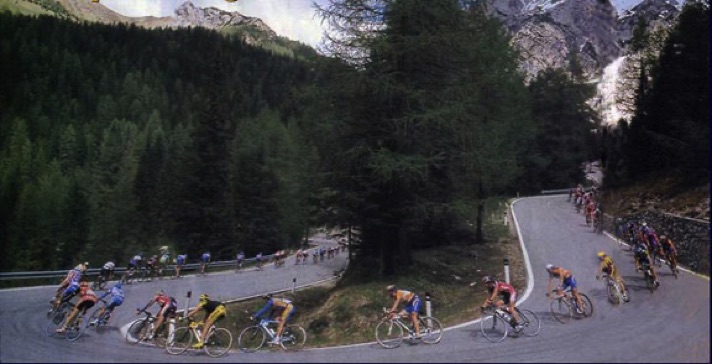
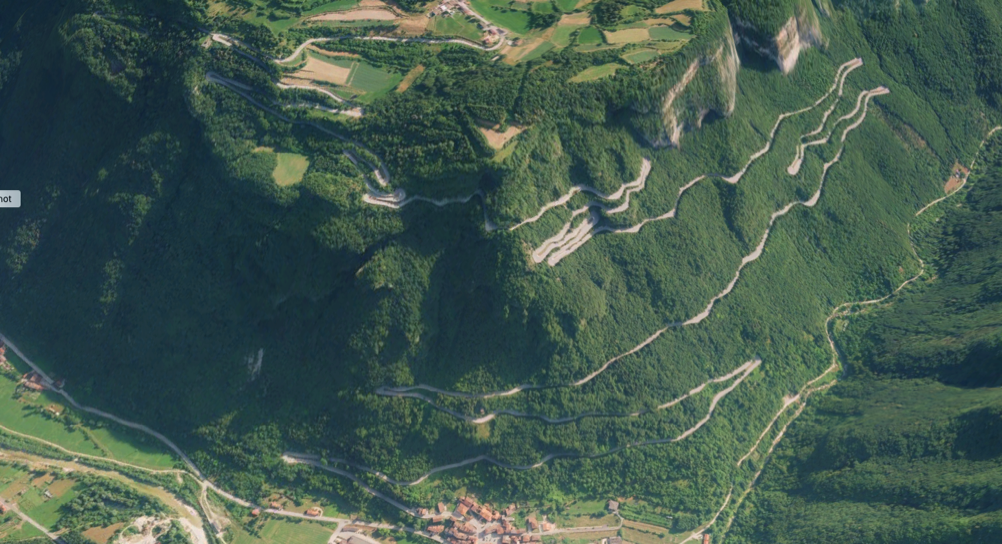
CYCLING IN THE HILLS AND MOUNTAINS OF THE VENETO
Much of the Veneto region is hilly and mountainous, and with few exceptions, the most scenic and engaging routes require a fair amount of uphill riding. Climbing is an integral element of cycling, and part of being a complete cyclist. There's nothing like the challenge, adventure, thrill, and satisfaction that comes with reaching high places under one's own power.
Mountain riding, however, requires preparation, as well as skills, capabilities, knowledge, and awareness that aren't always obvious to those approaching it for the first time. At the risk of sounding over-dramatic, I will state that ignorance or disregard of this fact can have grave consequences. A bike handling mistake, mechanical, puncture, bad weather, or crash, assume a different dimension when they happen on a road that leaves no room for error, or in sparsely populated areas that may not have cellular coverage.
On this page I'll share what I've learned over the course of several decades of riding, and leading rides, in the hills and mountains of the Veneto Region.
The best policy is, "Expect nothing, be prepared for everything. " (Zen dictum).
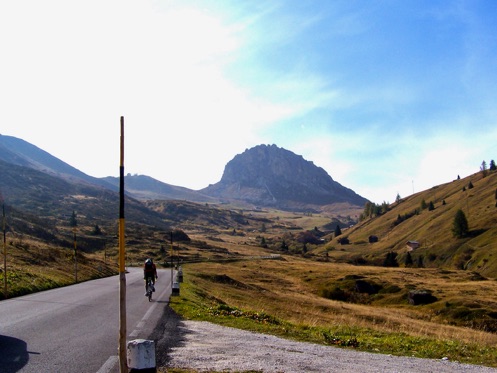
Image from Apple Maps
photo © April Pedersen Santinon
my husband climbing Passo Pordoi on a mellow autumn day
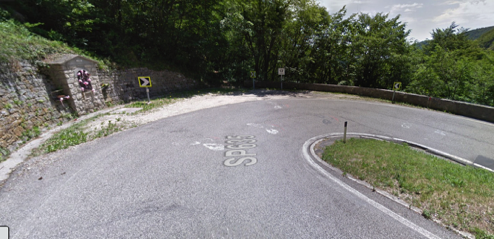
Google Street View screenshot
Passo San Boldo, Tornante 13
Have the right gearing! The old triple cranksets on my road and gravel bikes have been swapped for Miche Graff 30-46 cranksets, Miche cassettes (which allow you to choose the cogs you want), and Campagnolo 11-speed components. This setup provides a very low gear and a range of ratios that is adequate for every gradient and situation. Even the pros use very low gears on difficult clmbs, and macho gearing is a thing of the past.
If you're using wheels (especially older models) with non-standard spokes, it's a good idea to carry spares, as a mechanic may not have your particular spoke on hand. I once came across a group of visiting cyclists from another part of Italy as they were going from one bike shop to another, looking for a particular spoke for a wheel that was no longer made. Their rides were on hold and their trip somewhat ruined.
You'll want tires that are durable, offer low rolling resistance, have a supple feel, and provide a pleasant ride sensation, but most important, are grippy and secure on the descents, also in wet weather. 25 mm is now the standard tire width, with many riders even mounting 28's if the fork and frame permit it. Wider tires are not slower--quite the opposite. Descending on worn or improperly inflated tires is asking for trouble.
ESSENTIAL ITEMS
● Protective eyewear is imperative: a speck of dust or a bug smashing into your eye while you're descending at high speed could be calamitous. The temple pieces of your sunglasses should be worn outside of your helmet straps, but not because it looks pro: if you should crash, you would want your glasses to fall off, not get embedded in your face, Descending with your mouth open isn't a good idea either. A few years ago I collided with a bee while descending the Montello. It hit my mouth and stung the inside of my lip, which immediately began to swell. Imagine what would have happened if I hadn't had my mouth closed!
● Sunscreen is a given, and insect repellant is highly recommended: there's nothing worse than laboring up a climb with an annoying gnat buzzing around your face, or having a nasty horsefly bite right through your shorts, leaving an itchy welt on your thigh or behind (so don't neglect those areas when you apply the bug repellant).
● Think twice about the items you carry in your jersey pockets. I know of a rider who crashed on a descent and had some ribs broken by his mini pump. (Why would anyone even want to carry in one's pockets items such as a tube, levers, and CO2 canisters or pump, that are used infrequently? They make pockets bulge and sag, which is unsightly as well). (Phones and keys can be placed in cases or wallets, or cushioned).
● You should always carry an ID and medical information, and the name and telephone number of a contact person and/or the lodgings or home where you're staying. Keep these on your person (a dog tag or bracelet), not in your seat bag: in the event you're injured and unconscious, no one would think to look there, or you might find yourself taken to a hospital without your bike. Even keeping a card in your jersey pocket has its drawbacks. It could be destroyed in a crash, or the jersey could be cut off and discarded by medical personnel. I think it's also a good idea to carry your phone in your jersey pocket, in case you need to call for help, or phone friends or relatives from a hospital. If you set out alone, tell someone where you're going, and activate Find Friends or other location tracking app on your phone. I recall the first time I descended from Foza to Valstagna, a really lonely road down a sheer cliff in a canyon, and thinking, 'if I went off the road here, maybe someone would find my bones 20 years from now!'
● When heading for the mountains, always take a jacket, even on the warmest, sunniest day. I've heard many visiting cyclists relate their experiences of climbing Monte Grappa on a sweltering hot morning, reaching the summit soaking wet from perspiration, and being shocked by how cold it was up there. They hadn't brought jackets along, and began to shiver when they started the descent. (You may observe knowledgeable cyclists who first change into dry undershirts and jerseys when they reach the summit). Shivering diminishes your concentration and bike handling ability. You could become hypothermic and suffer from impaired coordination, reactions, and judgment, with disastrous consequences. A waterproof, breathable windbreaker that fits in your jersey pocket or in your seat, handlebar, or top tube bag, is better than nothing, but adding a vest, armwarmers, knee/legwarmers, Buff, long-fingered gloves, and shoe covers, is adviseable for high altitude rides. In a pinch you can always resort to the time-honored practice of stuffing pages of La Gazzetta dello Sport under your jersey (a plastic bag would work too but it's lacking in time-honored tradition :^) ). Do not wear your jacket while climbing; it will cause you to overheat and sweat, leading to chills when you reach the summit..
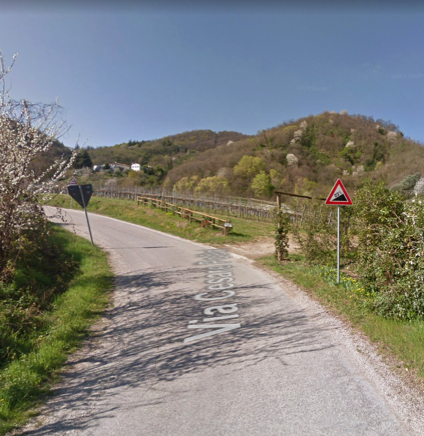
CONCLUSION
Mountains are never conquered. One who boasts of such "conquests" is arrogant and self-centered, or simply ignorant, insensitive, and naive. Summits are earned, with effort, will, and determination. Climbing is a spiritual experience, a communion, not an occasion for exalting one's ego. Mountains can teach us much about our own strength, character, and inner resources, if they are approached with humility, reverence, and respect, rather than a desire for self-glorification. If nothing else, being in the mountains should make us realize how small and insignificant we are, yet at the same time, that we are part of something grand and divine...both infinitesimal and infinite. Mountains have the power to reach deep into our souls and illuminate our being, if we will only let them.
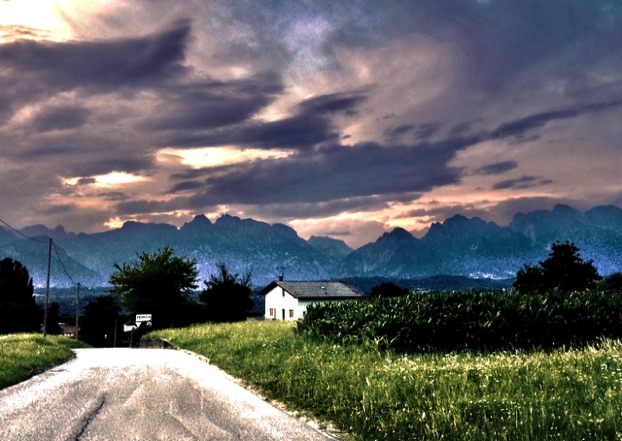
photo © April Pedersen Santinon
Don't be fooled by the modest heights of some of our hills: this innocuous-looking litte climb in the pleasant Euganean Hills rears up to 22%
Google Maps Streetview screenshot
KEEP IN MIND THAT...
● Bicycles are silent. You may think you have the road to yourself because you don't hear any motor vehicles, but there may be another cyclist approaching. A few years ago, a climbing and a descending cyclist had a head-on collision and one of them was killed. In granfondo rides, use your periferal vision (don't take your eyes off the road ahead) to check for cyclists overtaking you when you're setting up for turns on descents, A handlebar mirror is great for this.
● When you're rounding a curve, cars approaching from either the front or the rear may not be able to see you (or may be concentrating on taking their own line in the curve), so keep to the right unless you have a clear view way up or down the road (which is possible when the road doubles back on itself, and you can see vehicles above and below you). If you see a bus or large truck approaching a switchback that you're heading for, stop and give it the right of way.
MOTHER NATURE WILL ALWAYS HAVE THE UPPER HAND
Weather in the mountains can change rapidly and dramatically, and you can't always count on finding shelter when you need it. Nor can even the best rain gear keep you dry forever. Rain coupled with wind or fog can hinder your vision. Rain quickly transforms those radiant, poetic, mountains into a lonely, desolate, hostile, and potentially perilous place. I remember all too well the MTB Granfondo dei Cimbri on the Asiago Sette Comuni Plateau in July 2000, when we were hit by graupel that turned the ground white, made the rocky forest road slippery, and froze my hands (as well as the rest of myself). I could barely apply the brakes as I descended alone through the dark, thick, fir forest. Was I ever relieved to see volunteers and their rescue vehicle ahead, and so grateful to get a ride back down to Roana! At the Giro delle Dolomiti, it began to rain as I was rounding a mountainside, and I was suddenly hit by the full force of the wind, barely able to see or keep the bike upright and going forward. I searched desperately for shelter, which appeared in the shape of an underpass ahead. Just then the broom wagon came along and I clambered in and wedged myself between other cold, drenched riders, all of us stuffing large sheets of paper toweling under our jerseys. The driver kindly picked up a couple of riders who were not even in the event. Not doing so could have had serious consequences for them. When we stopped at the feed zone we observed riders who were shivering uncontrollably. After these and other similarly miserable experiences, I swore I would never again ride in mountains in the rain if I could help it, so at the 2004 GF Campagnolo, when It began to pour on the climb to Cima Campo, I turned around and rode back to Feltre, barely able to see. But a group of Americans who were at the cycling camp I worked for did not want to abandon a race they'd come several thousand miles to ride, and foolishly soldiered on. They were overcome by serious hypothermia, with one of them becoming delirious and hysterical, and all had to be rescued and taken to a firehouse, where they were wrapped in blankets and given hot tea. These incidents had one thing in common: they happened at organized events where there were rescue crews on hand. The outcome would have been far different, and in the case of the Americans, possibly tragic, if we had been on our own in the middle of nowhere.
Always check the weather report, and keep in mind that mountain weather can vary from one valley to the next.
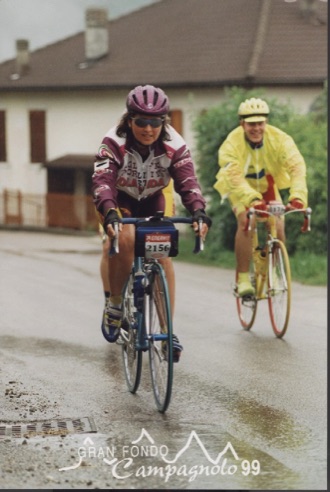
Arrgh! Why am I doing this? And why are we smiling?
CLIMBING TIPS for the UNINITIATED
● When starting a long climb, don't be in a hurry! Relax, breathe deeply, settle down, get into a rhythm, and resign yourself to the fact that you're going to be at this for a quite a while. Do not try to keep up with--nor wait for--other riders. Each cyclist has his/her own climbing pace, and should stick to it. Don't be looking way up ahead and thinking "yikes!" and "aargh!" Getting demoralized and anxious is counterproductive: it wastes energy and induces negative physiological reactions. Stay in the moment. Look around and enjoy the view. Smile. You will get up there and beyond, one pedal stroke at a time. You will find that as the minutes pass, you will feel better and stronger, as your system adapts to the effort.
● Don't spin madly in a tiny gear and go nowhere fast--you'll just tire yourself out in short order. Use a ratio that gives some resistance.
● Don't tense your upper body; keep your shoulders down, elbows bent (but not sticking out like Chris Froome's). Your upper body should be straight and quiet; only your legs should be moving: rocking your body from side to side, or bobbing your head, doesn't contribute to your forward motion, wastes energy, and looks ghastly. Don't mash the pedals. Once while climbing the Pordoi Pass to see a stage finish of the Giro Donne, I came upon a group of cyclists in a club. When I got alongside them they struck up a conversation...and subtly upped their pace a little, just enough so that I couldn't pass them. The rider next to me was a terrible cyclist. He was doing everything that I just said not to do: as he would push down hard on the pedals, his tensed body with locked elbows would jerk the bike to and fro, causing it to weave back and forth in the road. I was afraid he was going to knock me down. I didn't want to ride in back of him either as he looked none too capable (I've seen riders reach their limits and just fall over). I was trapped. The only thing I could do was keep as far away as possible from the inept, annoying, chap.
KEEP IN MIND THAT...
● Rain and wind send sand, pebbles, rocks, branches, and leaves into the road. Descending after a storm can be treacherous: debris can puncture or cut your tires; slippery leaves can cause a loss of traction, hitting objects can make you lose control. I recall being caught in a storm when doing a recon of a 15% climb on the GF Pinarello course. When I stood up to apply more power to the pedals, my rear wheel just spun round and round. Stopping and dismounting weren't easy; those slippery plastic cleats slid along the pavement. The descent was one of the scariest I've ever done. The tires seemed to be skimming on ice and I had no feeling of traction or control. (Disc brakes wouldn't have helped).
● Shadows can conceal patches of rough, cracked, and broken pavement.
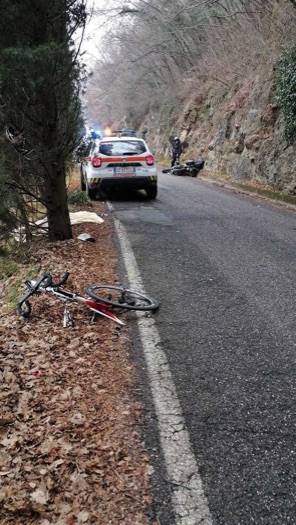
DESCENDING BASICS
The bad news is, great descenders are born, not made. Two-time Giro winner Paolo Savoldelli said this, and he should know--they didn't call him il Falco (the Falcon) for nothing. Watching him scream down a descent, exiting turns just inches from the edge of a cliff, was hair-raising. But that doesn't mean that we mortals can't improve our descending skills. Another legendary descender (and Giro winner), Fiorenzo Magni gave this advice to a rider whose feeble descending ability cost him a possible Giro stage win: "Take risks! So you break a shoulder here or an ankle there. It will heal and in the end you'll learn to be a better, faster descender." I am not recommending that you do this! Instead, I offer the following tips and techniques, which should make you feel more at ease when the road goes downhill.
● If riding a trainer is not adequate preparation for climbing, it is no preparation at all for descending! which requires knowledge, skill, and practice. Inexperienced cyclists who reach summits on e-bikes face a similar situation, but with an additional disadvantage: a heavy, less agile, and less maneuverable bicycle. There have been numerous serious, even fatal, crashes by cyclists who would not have been able to reach the places they did under their own power. Famed mountaineer Hans Kammerlander said, "A summit will not be yours until you're down again..."
● Your hands should be on the drops, with your fingers covering the brake levers. (I installed a set of Lizard Skins neoprene MTB brake lever sleeves, which eliminate slipperiness caused by perspiration or rain). Keep a firm, but not deathlike grip on the bars, and DO NOT take your hand(s) off them . If you follow pro racing, you will know that even pros have come to grief because they ignored this rule (e.g. Alberto Contador and Chris Froome).
● Do not try to keep up with other riders, who may have more experience and skill. (Ignoring this advice often leads to crashes, lost skin, and broken bones). Relax. Singing or whistling a tune helps. Don't tense your body; keep your shoulders down, elbows bent. A rigid body transmits jolts instead of enabling you to absorb and react to them. Keep your butt back on the saddle and your torso low, to counteract the force of gravity pulling you downward (which on an incline means forward), as well as for even weight distribution, and to lower your center of gravity.
● Your cranks should be parallel to the road. This distributes your weight better, keeps you more balanced, and enables you to use your legs as shock absorbers by raising your butt ever so slightly from the saddle. Doing that also takes your weight off the saddle and puts it on the pedals instead, lowering your center of gravity and increasing your stability. On long descents, it's good to rotate the pedals now and then, to keep blood flowing and to keep the muscles from stiffening.
at right: Strada Giardino, Monte Grappa. Feb. 2021, Perhaps the cyclist, who was descending, went wide and into the opposite lane as he approached the switcback, and collided with the ascending motorcyclist. The cyclist was killed; the motorcyclist was rushed to the hospital in critical condition,
Placing your behind farther back on the saddle and pushing forward gives you more leverage. Climbing out of the saddle takes more energy, but of course, the weight of your body helps deliver more power to the pedals. It's good to alternate styles. With experience, you'll know the right situation to utilize each. There's no right or wrong--it's a matter of one's strength, fitness, and physique, the slope angle, climb length, and even how you are feeling at the moment. Small, light climbers like the late Marco Pantani often stand. It's also a matter of one's own personal style. I do it as much as I can, as it gives me a "proactive" attacking feeling, rather than the more passive feeling I get when just sitting down and spinning along.
When you get to a switchback, avoid the temptation to cut the corner, because you'll only have to climb out of the apex, which is a steeper line, due to the banking. Keep to the outside and look for the relatively level spot. When you get to it, stop pedaling for a couple of seconds. You'll find that this micro-rest will allow you to recover and give your legs a burst of energy. (You can also take advantage of pull-overs, parking areas, and driveways to do this). This trick has kept me going when others have blown up, dismounted, and started walking. On a switchback you can then shoot down the banking as track riders do, and use your momentum to zip effortlessly up the climb for a few meters.
Do not eat while climbing. Digestion diverts blood flow and energy from the muscles and can lead to weakness and various forms of distress.
the descent from Castello Tesino to Grigno
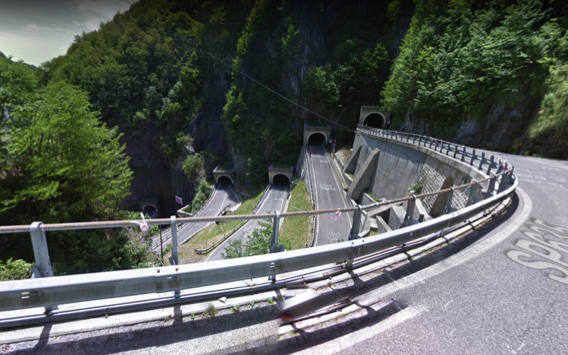
photo from local newpaper websites
Google Maps Streetview screenshot
● Keep your head up and look down the road, scanning for potential troubles, such as objects, dips, or broken pavment, and visualizing your line through the next curve. REMEMBER: YOU GO WHERE YOU LOOK! It's known as target fixation. If you focus on a spot where you don't want to go, like the edge of the road or an object you must avoid hitting, you will probably wind up going off the road or hitting that object.
● To control your speed, alternately feather the brakes. Don't apply them constantly, as this will heat up the rims (or hydraulic fluid), which could cause a blowout, disc brake fade, or (in the case of tubulars), melted glue and a loose tire. You'd be amazed how hot rims can get. I once had a flat on a very steep descent and had to wait awhile before removing the tire because the rim burned my fingers. On another occasion, as I was waiting for a friend at the base of Monte Grappa, some riders who had just descended stopped to remove their jackets, and one of them was horrified to see that his tubular was about to roll off the rim!
The recommended technique is to brake hard before the curve, then release the brakes as you enter it--this way, your bike will be accelerating as you exit the curve. If you slow down too much, you will creep around the apex and then have to pedal to accelerate. It takes a lot of practice and experience to know at what point and how much to brake, when to release the brakes, and how much speed you can carry through the curve. There are many determining factors and no magic formula. If you are new to the game, just try to do most of your braking before the curve, then continue to apply some pressure as you go into it.
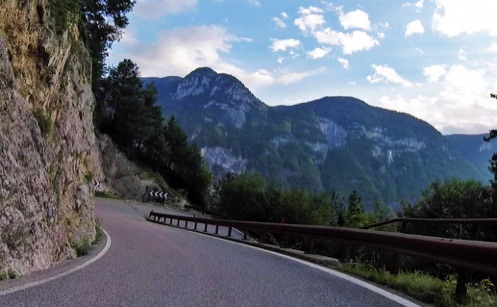
● The most important descending technique to master is counter steer, which literally means steering the bike in the direction opposite that of the curve. By steering I mean actually putting pressure on the handlebar. Think of it this way: in normal riding, without even thinking about it, you put slight pressure on your right handlebar to move to the left, and vice versa. But when you're in a right-hand curve, pushing forward on the right side of the handlebar will put the bike in a steeper lean to the right, tightening the arc of your trajectory. In a left-hand curve, pushing on the left side of the bar will make you lean more to the left and cut a tighter left hand arc. The greater the pressure, the greater the lean, and the tighter the arc. This phenomenon is determined by laws of physics, which you can use to your advantage.
Unfortunately, you can't always detect everything. One of my friend Mario's many crashes came when descending the south side of the San Boldo Pass. Without warning, his crank snapped in half, causing him to lose control and crash into a wall (he was lucky there was a wall!). In those days he didn't wear a helmet. With blood streaming from his head, he somehow managed to reach Tovena, the town at the bottom, where he sought help. This was not a wise thing to do: he could have suffered a dizzy spell or lost consciousness (not to mention the difficulty of descending with only one crank!). Mario noted that the crash happened on Tornante 13 where there is a little shrine dedicated to Sant'Anna, and he is thankful to her that he got off as lightly as he did. That's Mario, always looking on the bright side! (Note that the number 13 is not considered unlucky in Italy).
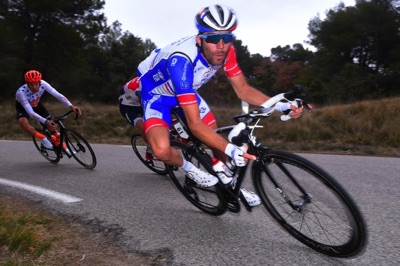
Copyright: (c)Tim De Waele, VeloNews
a great illustration of countersteering by Thibault Pinot
THE HEART OF THE MATTER
I've often come upon grimacing men (never women) flailing and contorting themselves on climbs, determined at all costs to reach the top, so I'm not surprised whenever I see a news headline about yet another cyclist who suffered a fatal heart attack. My friend Marisa tells the story of a time she drove past an overweight cyclist struggling agonizingly up a climb to the hill town of Asolo, and wondering how much farther he could go on. On the way back she came upon an ambulance and saw the man lying dead in the roadway. Men appear to be particularly susceptible to those cliché "inspirational" credos of never giving up. It makes more sense, though, to dismount your bike and push it, and live to ride another day. Even if you've been cycling for years, before cycling in the mountains or riding a granfondo for the first time, it's wise to see a specialist and make sure you're up to it. Take a look at this GCN video.
photo © April Pedersen Santinon
the unique and thrilling Passo San Boldo road
photo © April Pedersen Santinon
CRASHING
It's not pleasant to think about this but it's always a possibility, although crashing on a descent is almost always the result of imprudence, misjudgement, lapse of concentration, fatigue, overestimating one's abilities, or exceeding one's limits. If you realize you aren't going to make a turn and are heading towards a wall or guardrail, it's probably better to lay the bike down and slide than hit the obstacle head on and risk cracking your head or doing an endo into thin air. When falling (in any situation), hold onto your handlebars and do not put out your hand to break the fall. It won't keep you upright and you'll probably break your wrist, as happened to an inexperienced person on a ride I led once. Note how the pros unclip and extend one leg instead. If that's impossible, then let your shoulder and hip take the impact, keeping your head up (broken collarbones are a common cycling injury). Rest assured that people will stop to help you and summon first aid if necessary.
For emergency medical services, call 118
But in the end, just knowing the techniques isn't enough to make you a fearless descender. It goes back to what Il Falco said--you have to be born with that innate fearlessness, not to mention extraordinary reactions. I would probably be more inclined to go all out if I could see around curves. How do I know I won't encounter a cow in the road, or a pile of slippery cow manure!, or a deer or feral hog, a fallen cyclist, a branch or boulder, a rivulet of water, or a lumbering tractor? How do I know I won't run over something that will cause a tire to blow out?
Flavio Vanzella, a yellow jersey wearer in the Tour de France, once gave me this advice: concentrate so much on the descent, be so into what you're doing, that you can't think of anything else. (This is known as a flow state). Racers can allow themselves to do this because they know that the roads are clear...and in fact, they often know the roads, having ridden them in previous races or recon rides. They are experienced, highly skilled, experts, riding with others who are the same, and...they are getting paid to take risks! None of these these factors applies to us, so in the end, being a fearless descender is not something that we should even aspire to be.
If anyone makes a derisive comment about my low gears or slow speed, who cares? I'm the one riding the bike, not them. If someone enjoys feeling superior, let them. So they are stronger and faster than I. So what? What do I have to prove? My self-image is based on more than the sizes of my chainrings and the number of teeth on my cogs!
There doesn't exist a cyclist who doesn't enjoy passing another rider on a climb. But before feeling smug or superior, one should consider: maybe that person doesn't have as much time to train as you do. Or is recovering from illness or injury. Is new to the sport. Is having a jour sans (a day without...legs). A recovery day. A pain. A cramp. A crisi di fame (bonk), mechanical problem, or a crummy bike. Maybe he/she had a triple bypass! (Or maybe, just maybe, she wants to ride slowly, observe, enjoy the scenery and savor the sensations). So unless you have won a race against your peers (an actual race, not a Strava segment), feeling good about your climbing accomplishments should not be based solely on feeling superior to others. (And even then, just who are those peers you beat?) Of course we are all allowed to feel scornful of those who ride up on e-bikes!
The opposite is also true: you shouldn't feel bad about a climbing experience based on feelings of inferiority to others. A satisfying climb should mean: You felt good! Every muscle of your body and all of your systems worked like a well-tuned machine. You climbed with good style. Practiced good roadcraft. Used your gears with precision and maximum efficiency. Stood on the pedals at the right moments, felt the bike respond, enjoyed feeling that little surge of power. Felt in harmony with the mountain. Thought how lucky you were to be healthy, strong, skillful, and able to be in that place at that time.
Euphoria, satisfaction, and pride are our rewards as climbers, and we all are entitled to enjoy them (with the exception of e-bikers), regardless of how fast we climb or what gears we use.
BiciSport Magazine photo
PREPARE YOUR BICYCLE
It's a cliché to say "check your bike and make sure it's in the proper condition," but it's essential when you're going to ride in the mountains. Not only does your safety, and maybe your life, depend on it, but knowing that you can trust your bike gives you confidence and lets you concentrate on the task at hand, and minimizes the chance that anything will go wrong. Every nut and bolt on your bike should be examined: stem, brake levers, brake blocks, brake and derailleur cable anchors, seat post clamp, water bottle cages, even your computer bracket. All bolts should be torqued to spec: I've seen three carbon seatposts cracked from overtightening. Disc brakes are not foolproof or immune to problems. Wheels should be true, and spokes should have the proper tension. Check tire treads for wear, cuts, and embedded debris, and avoid using patched tubes. Ensure that tires are mounted/seated properly on the rims. Rim strips are an item most people give little or no thought to, but worn or displaced ones can expose the edges of the nipple holes, which can then cut your tube. (I once had a succession of flats caused by a sliver of aluminum embedded in the rim strip; it was so tiny that I could only find it with a jeweler's magnifying lens!) Know how to repair a flat! Worn chains or cogs can cause the chain to skip. It's easy to be distracted when working on your bike and forget to complete a task, so double check everything. If you've had a crash you should be extra wary, as your bike may have suffered unseen damage. I've encountered many riders who neglected to check the condition of their cleats. Worn cleats can lead to an inadvertent release. This happened to a cyclist I once knew when he stood up on the pedals at the crest of a little climb. He lost his balance and fell, hitting his head on a curb. He wasn't wearing a helmet. He spoke his wife's name, slipped into a coma, and died eight months later. When I visited his wife she showed me his bike, which wasn't damaged at all. It was a tragic and sobering sight. Loose cleat bolts can lead to accidents too, if the cleat shifts position and causes a loss of balance or the inability to unclip. When cleats are replaced, the bolts may loosen after a period of riding, and need to be re-tightened.
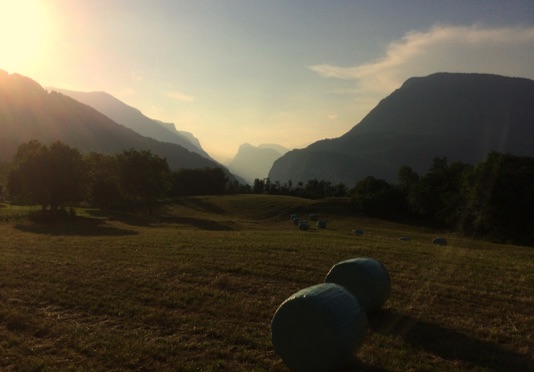
RIDE YOUR OWN RIDE
Aside from training, and physical limitations resulting from injuries or conditions, there are also genetically-determined physiological factors that influence one's climbing ability. (Otherwise, everyone would theoretically be capable of winning a climbing stage in a grand tour). We are not all created equal, but we all do have an equal right to cycling fulfillment. Just because someone else climbs faster or with larger gears, it does not diminish what we do, nor mean that we shouldn't feel satisfaction and pride in our climbing accomplishments. (There is always going to be someone faster!) We should always try to push ourselves, better our performances, and redefine our limits, but at the same time, realize that we do have them, and accept ourselves for what we are. An inability to do this only can only lead to unhappiness, self-destructive emotions, and in some cases, doping. And for what?
photo from BiciSport Magazine
photo © April Pedersen Santinon
an evening descent from Enego
Do not suddenly apply your brakes hard in a curve, as this will lock up your wheels and cause a skid or fishtail. If you must brake in a curve, straighten the bike and apply pressure gently and evenly. The correct line is to drift to the outside of the curve, cut across the apex, and exit wide on the other side. Oncoming automobiles may make this impossible, however, as do some roads, which have steep, tight little hairpins that offer no room. Keep your inside pedal up, and transfer your weight decisively onto your outside pedal, just as in downhill skiing. Lean your bike into the curve.
PREPARE YOURSELF
Being from New Jersey, I know how hard it is to train for miles-long climbs when you live in a place where there are none (NJ does have some very steep climbs, but they are short). I recommend doing time trial training (climbing, like TTing, requires a hard, steady effort) and hill intervals on whatever slope you have at hand; even an overpass or bridge can be hard when ridden all out, repeatedly. Climbing takes raw power as well as aerobic fitness; spinning workouts in the gym or riding your bike on a smart trainer are not adequate preparation for really tough climbs. There's no substitute for actually riding on the road, with its variety of surfaces, winds, change of gradients, and so on. Gravel and mountain bike riding are also excellent for developing power, balance, and the ability to handle the bike in unusual and unforeseen conditions, such as rough or unpaved sections of road. Practice riding out of the saddle whenever you can--it's an important tool to have at your disposal, but it takes upper body and core strength, which weight training can develop.
● Transitioning smoothly between sitting and standing is an essential skill. If you suddenly stop pedaling when going from sitting to standing or vice versa, the rider behind you may run into your rear wheel and go down. If you are sitting, keep pedaling as you pull yourself to a standing position. If you are standing and feel your legs starting to go, don't hesitate, but lower yourself smoothly to the saddle as you keep pedaling. Good balance and smooth, round pedaling action are important too--especially if you find yourself advancing at 3 mph.

please do not do this!
